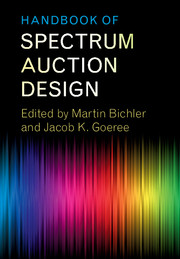Book contents
- Frontmatter
- Contents
- List of Contributors
- Preface
- List of Papers
- Part I The Simultaneous Multiple-Round Auction
- Part II The Combinatorial Clock Auction Designs
- 5 Combinatorial Auction Design
- 6 The Clock-Proxy Auction: A Practical Combinatorial Auction Design
- 7 Spectrum Auction Design
- 8 A Practical Guide to the Combinatorial Clock Auction
- 9 Market Design and the Evolution of the Combinatorial Clock Auction
- 10 Quadratic Core-Selecting Payment Rules for Combinatorial Auctions
- 11 Core-Selecting Package Auctions
- 12 A New Payment Rule for Core-Selecting Package Auctions
- 13 On the Impossibility of Core-Selecting Auctions
- 14 Ascending Combinatorial Auctions with Risk Averse Bidders
- 15 Properties of the Combinatorial Clock Auction
- 16 Budget Constraints in Combinatorial Clock Auctions
- 17 (Un)expected Bidder Behavior in Spectrum Auctions: About Inconsistent Bidding and its Impact on Efficiency in the Combinatorial Clock Auction
- Part III Alternative Auction Designs
- Part IV Experimental Comparisons of Auction Designs
- Part V The Bidders’ Perspective
- Part VI Secondary Markets and Exchanges
- Outlook
- References
10 - Quadratic Core-Selecting Payment Rules for Combinatorial Auctions
from Part II - The Combinatorial Clock Auction Designs
Published online by Cambridge University Press: 26 October 2017
- Frontmatter
- Contents
- List of Contributors
- Preface
- List of Papers
- Part I The Simultaneous Multiple-Round Auction
- Part II The Combinatorial Clock Auction Designs
- 5 Combinatorial Auction Design
- 6 The Clock-Proxy Auction: A Practical Combinatorial Auction Design
- 7 Spectrum Auction Design
- 8 A Practical Guide to the Combinatorial Clock Auction
- 9 Market Design and the Evolution of the Combinatorial Clock Auction
- 10 Quadratic Core-Selecting Payment Rules for Combinatorial Auctions
- 11 Core-Selecting Package Auctions
- 12 A New Payment Rule for Core-Selecting Package Auctions
- 13 On the Impossibility of Core-Selecting Auctions
- 14 Ascending Combinatorial Auctions with Risk Averse Bidders
- 15 Properties of the Combinatorial Clock Auction
- 16 Budget Constraints in Combinatorial Clock Auctions
- 17 (Un)expected Bidder Behavior in Spectrum Auctions: About Inconsistent Bidding and its Impact on Efficiency in the Combinatorial Clock Auction
- Part III Alternative Auction Designs
- Part IV Experimental Comparisons of Auction Designs
- Part V The Bidders’ Perspective
- Part VI Secondary Markets and Exchanges
- Outlook
- References
Summary
Introduction
Combinatorial auctions represent one of the most prominent areas of research in the intersection of Operations Research (OR) and Economics. First proposed for practical governmental applications by Rassenti et al. (1982), a combinatorial auction (CA) is an auction for many items in which bidders submit bids on combinations of items, or packages. CAs also are referred to as “package auctions” or auctions with “package bidding.” In a general CA, a bidder may submit bids on any arbitrary collection of packages. The “winner-determination problem” identifies the value maximizing assignment given the package bids. This problem is as complex as the Weighted Set-Packing problem, and hence NP-hard (see Rothkopf et al. 1998).
Thus, in the many real-world applications of CAs, the computational techniques of OR facilitate more efficient economic outcomes in environments too complex for classical (i.e., non-computational) economic theory. Conversely, the game-theoretic framework surrounding CAs provides a host of new computational challenges and optimization problems for OR.
One critical element of any CA is the pricing rule, which determines what each winner pays for the package won. In this paper, we present a new class of optimization based pricing rules for combinatorial auctions in general, demonstrate some of their unique features, and elaborate upon some properties of the larger class of core-selecting mechanisms. We also describe the use of this algorithm for recent and upcoming spectrum-license auctions in the United Kingdom, for upcoming spectrum auctions in several European countries (e.g., the Netherlands, Denmark, Portugal, and Austria), and for use in the United States for the Federal Aviation Administration's (FAA) proposed allocation of landing rights to control congestion at airports. Further, we provide the relevant economic interpretation and theoretical basis for our algorithm's various features.
The use of auctions for allocating spectrum-license-rights to telecommunications companies gained prominence in 1994 when the Federal Communications Commission (FCC) began to use a Simultaneous Ascending Auction (SAA) to sell spectrum licenses in the United States. The initial design, which is still used today with only slight modifications, avoided the idea of a “combinatorial” or “package” auction, in which bidders bid on packages of licenses because of the inherent computational difficulty.
Information
- Type
- Chapter
- Information
- Handbook of Spectrum Auction Design , pp. 195 - 225Publisher: Cambridge University PressPrint publication year: 2017
References
Accessibility standard: Unknown
Why this information is here
This section outlines the accessibility features of this content - including support for screen readers, full keyboard navigation and high-contrast display options. This may not be relevant for you.Accessibility Information
- 4
- Cited by
